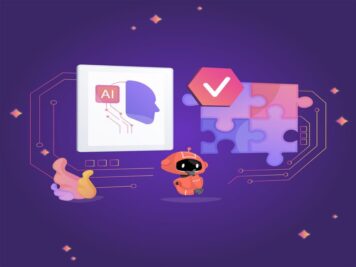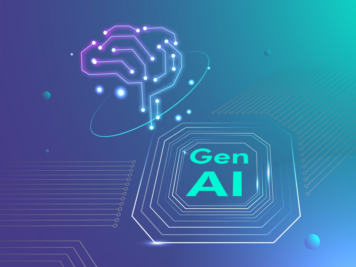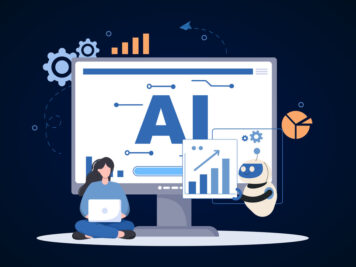You’ve seen the AI headlines. Every week, it’s a new acronym. A new tool. A flashy demo. Or another wrapper around GPT claiming to change everything.

But if you’re running a company, leading product, or driving growth, the question isn’t “what’s new?” It’s, “what’s useful for my business?”
That’s why many CIOs are getting bullish on AI agents. Not because they are trendy or new but because they deliver were traditional AI or Generative AI falls short.
Yes, Agentic AI one that doesn’t just assist—it acts.
Autonomously. Intelligently. At scale.
Let’s understand it with an example:
From clunky processes to intent-driven automation
In a typical enterprise, how much time, money, and human capital is wasted on soul-crushing, repetitive tasks?
Take expense claims.
The old way? Your teams download the receipts, manually fill forms, navigate clunky menus. It’s a time sink.
Now imagine this – An employee simply types, “I want to submit a claim.” An agent kicks in- pulls receipt from emails, applies company rules (like flagging high amounts), fills out the form, and either sends it via chatbot for review or submits it directly into your system.
Now that’s a strategic advantage.
And it’s not theoretical – Gartner predicts that by 2027, 50% of business decisions will be augmented or automated by AI agents.

Because when AI goes from passive assistant to proactive executor —that’s when your team stops using AI and starts compounding outcomes.
The smartest companies are already integrating Agentic workflows to streamline ops, accelerate decision cycle, and reduce cost-to-execute. The ones that don’t? They’ll be stuck duct-taping dashboards while the competition automates outcomes.
Let’s break down what Agentic AI actually is, how it works, and why the smartest product leaders and CXOs are betting on it as their next growth lever.
Also Read: Thinking of Implementing Agentic AI? Here’s What No One Tells You (And How to Handle It)
What Agentic AI truly means for your business
Most AI conversations get lost in abstraction. But if you’re sitting in the C-suite, there’s only one filter that matters: Does this materially improve how we operate and compete?
Agentic AI isn’t just a marginal improvement over your current stack. It’s a systemic upgrade in how work gets done end to end.
At its core, this isn’t about replacing tasks. It’s about delegating outcomes. Here’s what that really looks like when you map it to business value:
From instruction-following to outcome-ownership
Most GenAI tools are like interns—they wait for direction. You prompt, they respond.
Agentic AI, on the other hand, acts more like a seasoned operator. You tell it what you’re trying to achieve, not how. It plans, executes, iterates—without hand-holding.
Instead of micromanaging a process like “resolve ticket X,” you say, “reduce response time across Tier 1 support.” The agent figures out the path. And keeps adjusting as it learns.
This doesn’t just cut operational noise—it liberates your team to focus on the decisions that move strategy, not just workflow.
It doesn’t just work—it learns how to work better
Agentic AI thrives in live environments. Where traditional automation fails with shifting inputs, agentic systems evolve. Constantly.
They synthesize fresh data, react to context adjustments, and self-optimize—whether by re-prioritizing activities in the middle of the process or altering message depending on customer feedback.
This is real-time adaptability, not rule-based logic. Consider fewer fragile automations and more solutions that genuinely improve as you use them.
Amazon’s warehouse robots are doing this daily. And now, that same kind of adaptive learning is hitting back-office operations, IT, customer service, and even sales workflows.
Autonomy = Scale without headcount bloat
This is where CFOs start paying attention.
Agentic AI isn’t about marginal gains. It’s about decoupling growth from resource load. When systems can operate with less oversight—and still make quality decisions—you unlock scale without a proportional cost curve.
Take ServiceNow’s 50% reduction in routine workload through agent-driven automation. That’s not just more efficient. That’s a structural shift in how value is delivered across departments.
When AI can close the loop on processes without someone babysitting every click, you get compound returns: faster cycles, fewer blockers, and people focused on what actually requires human judgment. And when you deploy it in the right places, the ROI speaks for itself.
In essence, Agentic AI isn’t another tool in your tech stack.
It’s a shift in how your business runs—from manual to intelligent, from reactive to proactive, from controlled to orchestrated. And the organizations that internalize this early? They won’t just move faster. They’ll compete on an entirely different playing field.
Beyond optimization- rethinking how work gets done
For years, AI tools helped humans become more productive. GenAI generates content, summarizes calls, surface insights.
Helpful? Yes.
Transformative? Not quite.
Every one of them still depends on a human to push things forward. One step at a time: prompt → check → edit → decide → act.
That’s not transformation. That’s optimization.
Agentic AI is different. It moves the center of gravity from human-directed tools to system-directed action. The difference? You’re not just accelerating execution—you’re redefining who (or what) is executing.
As pointed out in the webinar, agentic systems “don’t just support our work—they actually work for us.” That’s not semantics. It’s a complete repositioning of how work happens inside your org.
https://www.talentica.com/webinars/will-agentic-al-replace-or-reinvent-saas/

Let’s zoom out.
In the past, we moved from on-premise, where every piece of infrastructure was your problem, to SaaS, where you consumed software as a service.
Each step liberated resources. Agentic AI is the next, logical, and most profound liberation. It’s about liberating your people from the tyranny of the mundane.
When systems “understand intent, take action, and adapt dynamically,” your organization gains an unprecedented level of agility and responsiveness. Your role as a leader shifts from managing tasks to defining outcomes and empowering intelligent systems to achieve them.
The “human in the loop” isn’t gone; it’s elevated. It becomes about strategic oversight, ensuring alignment, and intervening only when truly necessary, allowing your teams to focus on what only humans can do: innovate, strategize, and connect.
The core components powering Agentic AI
When you bring Agentic AI into your enterprise, you’re not just deploying “smarter automation”—you’re building a system that can observe, decide, act, and adapt, often without a human nudging it along at every step. To do that, the agent needs a well-orchestrated architecture under the surface. This isn’t about understanding code—it’s about understanding what, exactly, your investment enables.
Also Read: Revamping prompt augmentation: Multi-agent architecture and LangGraph
Here’s a breakdown of the core functional building blocks behind intelligent agents—and why they matter to your business outcomes:
Perception
This is where everything starts. The agent needs to understand what’s going on. That could mean parsing a customer message, reading a system log, analyzing a spreadsheet, or pulling insights from a video.
It’s more than just data—it’s interpretation. NLP for text, vision models for images, speech-to-text, sensor inputs… all the ways an agent can take raw input and turn it into something actionable. If this part’s weak? Everything else falls apart.
Planning
Once the agent knows what’s happening, it figures out what to do next. Not just “reply to this email,” but how to break down a goal into real steps, prioritize them, and execute.
This is what separates a reactive script from a proactive system. It doesn’t just respond—it builds a plan and adapts on the fly if things change. That’s why this layer is so powerful in operations, logistics, customer experience—you name it.
Memory
You know those annoying bots that forget everything you said two minutes ago? Yeah, this fixes that.
Good agents have both short-term and long-term memory. They remember conversations, recall business rules, and learn from past outcomes. Whether it’s remembering a customer’s last support issue or tracking how a workflow performed last quarter, memory gives the agent context—which makes it smarter, more useful, and less frustrating.
Reasoning
Here’s the brains of the operation. Reasoning is how agents make decisions—comparing options, evaluating outcomes, and picking the best next step.
Simple systems follow a script. Smart agents figure it out based on goals, probability, logic, and experience. They can even ask, “What’s the best outcome here?” not just “Did I check the box?”
This is what makes agentic systems good at solving complex, messy, real-world problems. It’s not just about being fast—it’s about being right.
Action + Tool Use
Okay, so it can understand, plan, and decide. Now it needs to do something.
That could mean calling an API, pulling data from a CRM, sending an email, filling out a form, moving a robot arm—whatever the job is, the agent has tools to make it happen. It’s like giving it hands, so it’s not just a brain in a jar.
Good agents know when and how to use the right tools, not just that they exist.
Communication
If the agent can’t talk, it can’t help. This part handles all the back-and-forth—responding to users, collaborating with other agents, syncing with software systems.
Whether it’s a chatbot, a virtual assistant, or a behind-the-scenes agent managing supply chain ops, communication is what keeps it integrated into your workflows. It’s also how you build trust—by making sure the agent is responsive, clear, and aligned with the tone of your brand or business.
Learning
This is what makes it all worth it. A learning module means your agent doesn’t just run—it improves.
It learns from feedback, data, interactions, success, failure—all of it. That could mean refining how it routes support tickets, adjusting pricing strategies, or identifying new customer patterns. Without this, your agent is static. With it, you’ve got a system that gets more valuable every single day.
What happens when you deploy it right? Our success stories
When you connect all these components- perception, reasoning, planning, memory, tool use, and learning- you don’t just get smarter automation. You get a system that delivers outcomes, adapts in real time, and scales without linear cost.
Automated Marketing Campaigns with Agentic AI Systems
A marketing startup wanted to revolutionize digital marketing with autonomous AI workers who can plan, run, and optimize digital outreach with minimal human input. We developed a collaborative, multi-agent system that generated campaign content, analyzed performance, and adapted in real time.
From flash sales to product launches, campaigns ran autonomously while marketers stayed in control through human-in-loop checkpoints. The results? Higher ROI, faster iteration, and the ability to scale campaign volume- without scaling headcount.
Streamlining Business Processes with Autonomous AI
A forward-thinking enterprise set out to build autonomous business applications capable of handling complex operational tasks with precision. We deployed agentic systems that parsed vendor invoices, extracted metadata across Postgres and MongoDB, and constructed a knowledge graph to map relationships across entities.
A natural language interface translated human queries into SQL, while agents autonomously ran predictions and cross-database queries. The results? Faster insights, zero-touch reconciliation, and a scalable foundation for data-driven decision making.
Read All the success stories in detail here
Where to start (Roadmap to deploying Agentic AI)
You don’t need a moonshot to start. The smartest organizations start small—but design for scale.
Here’s how to approach it:
Pinpoint High-volume, outcome-defined workflows
Look for areas with clear intent but bloated execution, such as support triage, expense claims, user onboarding, order tracking, and internal IT request. These are ideal for agentic automation.
Begin with single agent use cases
Deploy a narrow agent to do a certain job. Focus on results (e.g., “reduce ticket backlog by X%”) rather than features. Measure, iterate, and learn.
Layer in autonomy + feedback loops
Once trust builds, give the agent more planning and reasoning capabilities. Allow it to learn from data and make decisions with minimal human supervision.
Scale through agent orchestration
Move from standalone agents to agent ecosystems. Design systems where agents collaborate, share memory, and self-optimize across workflows.
Establish guardrails and governance
Autonomy requires control. Implement oversight, ethical boundaries, and performance monitoring from day one—especially for customer-facing or compliance-heavy use cases.
Conclusion
What you get out of it will depend on how you begin. Agentic AI aims to streamline execution in situations when results are obvious but procedures are ineffective, not to replace teams. When carefully built, autonomous agents can deliver quantifiable gains across areas, including financial operations, internal IT, support processes, and data analysis.
However, execution is crucial. To develop credible, compliant, and scalable systems, you need more than just an LLM; you also need the right architecture, data access plan, feedback loops, and oversight.
Talentica can help with that.
We assist forward-thinking firms in transitioning from isolated AI efforts to structured, agentic systems that improve work processes. From creating task-specific agents to deploying comprehensive orchestration frameworks, our engineering-first approach ensures that autonomy is integrated with intent rather than just bolted on.
If you’re interested in exploring where agentic systems can generate actual value within your organization, we can help you get started in the right way.









